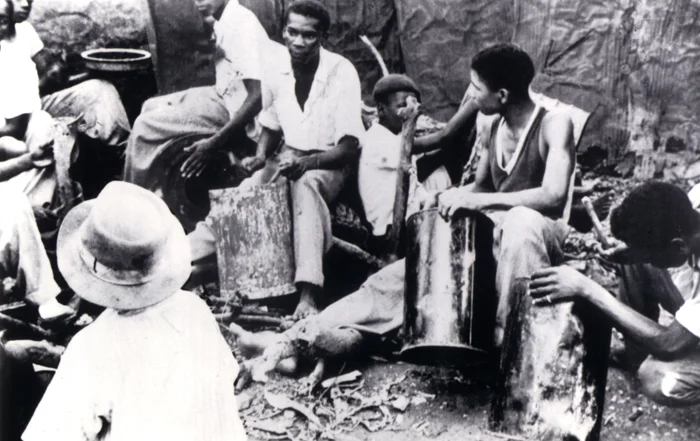Celebrating Mother’s in Music
Learn More

Earlier this year the United Nations adopted a Draft Resolution at its 92nd Plenary Meeting, declaring that “World Steelpan Day” was to be observed annually on August 11th on the UN calendar. Now, just what could be so special about this instrument that it would deserve such an honor?
Well, in the first place the “steelpan” is actually a whole family of instruments, and the claim is that it’s the only new family of acoustic instruments invented in the 20th century! Interestingly enough, the steelpan may also be an entirely new class of instrument. Musicologists classify musical instruments as: aerophones-the wind instruments; chordophones-the string instruments; membranophones-like drums; and idiophones-like cowbells, maracas and xylophones. While many would be quick to classify the steelpan as an idiophone, there is actually a case to be made that the metal surface that’s struck, is a stretched steel membrane that behaves like a drum skin in the way it vibrates when hit, and therefore suggests that the steelpan should be classed as a membranophone! The instrument could therefore be considered a hybrid of a membranophone and an idiophone in the way it behaves physically and so may be an entirely new class of instrument! This would also explain why, for a long time, the instruments were intuitively called steeldrums.
But enough on the physics of this new instrument, if you thought all that was fascinating wait till you learn about the history behind the invention and development of this new instrument family!
The entire family of steelpan instruments was invented in the Caribbean island of Trinidad, and eventually made the national instrument of the country of Trinidad & Tobago. Like many of the islands in the Caribbean, Africans were brought to Trinidad as captives and enslaved as workers on sugar cane plantations. The enslaved Africans, coming from drum centric cultures on the African continent, found ways to make and play drums on the plantation. This was frowned upon by the plantation owners and overseers, who had eventually realized that the Africans could send encoded messages using drums, and were plotting rebellions and escapes using drum dialogs between estates or plantations. The colonial government of Trinidad eventually banned the use of drums at all afro-centric ceremonies. But percussive accompaniment was so important in religious ceremonies and what little fun activity they were allowed, that the African slaves in Trinidad responded to the ban by creating bamboo instruments to replace the banned drums.
These “Tamboo Bamboo” percussion ensembles were the driving force in the pre-Lenten Carnival celebrations, brought to Trinidad by the French plantocracy and adopted by their former African slaves, once those slaves were emancipated in 1834. In the mid to late 1930s, as metal containers started to become more prevalent in the society at large for storage of commercial goods, discarded metal containers started finding their way into these percussion ensembles, and here is where serendipity and sheer Black genius met and created magic.
Vigorous beating of these empty metal containers with sticks or metal rods would sink the bottom surface being struck. The percussionists would then hammer the sunken metal surface back out into a convex configuration to continue beating out percussive patterns. Some resourceful percussionists noticed that “notes” would often emanate from accidental dents in the metal surface and would sometimes allow three and four note nursery rhyme ditties or bugle calls to be played on the bottom surface of a metal container. They started intentionally denting the metal surfaces to create these “notes.” One particular group of percussionists in the city of Port of Spain, known eventually (1938) as “Alexander’s Ragtime Band,” caused a sensation with this new technique in the carnival festivities of 1935 and the technique of finding notes in the dented convex bottom surface of tin cans took off like wildfire. Most Tamboo Bamboo percussion groups discarded their bamboo instruments and started using metal cans instead.
Steelpan pioneer Neville Jules reminds us in a critical video interview on “When Steel Talks,” (YouTube Channel-WSTglobalHD) that these early “ping pong” instruments were not capable of playing complete melodies. They were used to beat out short melodic phrases in call and response ditties that would usually involve a vocal chorus of masqueraders. This is an important distinction that most steelpan historians fail to make. Asked in the interview which other steelpan pioneers were important at this critical period in the evolution of the instrument, Jules names just one, Elliot Anthony Mannette.
Watch Neville Jules – Upclose – A When Steel Talks Exclusive Interview
Mannette was a member of “Oval Boys,” a small group of percussionists in Woodbrook, a Port of Spain suburb. This was a group of young boys who would not be let anywhere close to the Tamboo Bamboo groups of the time. Ellie was totally fascinated by the enterprise of making these “ping pong” instruments, but very frustrated at not being able to generate these ‘magic’ notes in a consistent way by pounding dents in a beaten out convex bottom surface of a metal container. Somewhere in 1941, he made what was probably the most important intuitive leap in the crafting of this new instrument, he decided to sink the bottom metal surface inward into a concave dish shape and delineate separate note areas which he would then “bubble” up as individual convex notes. This technique spread quickly across the island of Trinidad and to the sister island of Tobago and kickstarted the development of the modern steelpan instrument family. There was a competitive scramble among these young instrument craftsmen to place the largest number of notes on bigger and bigger pans or metal drums. The intuitive genius of these young men solved a number of problems that they faced in trying to make orchestral instruments out of discarded metal containers and metal drums.
On any steel drum/pan you have to solve for inharmonic vibrations on neighbouring notes. Remember, any note that’s struck will trigger vibrations across the entire metal surface or membrane and even the metal “skirt” of the pan. That’s why you won’t find the notes on a pan laid out like they are on a xylophone or piano, semitones next to each other. On a steelpan, the vibrations on any given note, “interfere” with the notes next door, if they are just a semitone apart. Turns out, it’s better to place notes that have sympathetic harmonics next to each other, while keeping the ones that don’t, as far away as possible. Somehow, the early instrument makers worked this out without really understanding much about the harmonic series!
Then in general, on any steel pan, the larger the note the lower the pitch. And the converse is of course true, the smaller the note the higher the pitch. But what size is the ideal size for each note? Trial and error? Intuition? Genius? They somehow worked it all out!
Next, when the steel drum surface is hammered into the concave shape before note layout is done, the metal is badly distorted and won’t vibrate freely, and therefore will be almost impossible to tune accurately. Again, serendipity played a role, as the discarded metal containers and drums used in early experimentation, often had paint or other oily residues inside. In burning away these residues, the fledging instrument makers realized that this made the metal easier to manipulate and tune. And, more importantly, improved the tone of the notes. Turns out that the steel vibrates more freely. So after “sinking”, “grooving” and “bubbling notes” is completed, each drum is heated or tempered before any actual note tuning is attempted.
Then in general, the lower the pitch range of the notes on a pan, the longer the “skirt” and shallower the concave surface depth. And of course, the converse is true. But what length skirt is the right length for each type of pan? And how deep should the concave sink of the drum surface be? Trial and error? Intuition? Sheer genius? They somehow worked that out too! By 1947, Mannette had crafted a steelpan with two complete diatonic scales which he played on Radio Trinidad, the first time a steelpan was broadcast on air.
In 1951 another critical inflection point was reached in the development of this new family of instruments. Trinidad sent a delegation of 11 steelpan players to London to perform at the Festival of Britain under the direction of Barbadian musician, Lt. Joseph Griffith, a well-respected band leader who had worked with a number of police bands in the Caribbean. Most of the young men selected for the trip were instrument makers as well as players and Griffith demanded that all the instruments were fully chromatic and tuned to concert pitch. Ellie Mannette’s 23-note lead steelpan or “tenor pan” was the instrument of choice for the frontline melody players. This steelpan was made from a 55-gallon oil drum, as were all the other instruments in the ensemble. Griffith had demanded that multi-drum background instruments were made to provide enough notes for full harmonic support for the wide repertoire of tunes he selected to present in London. It was the first time all the instruments in a steelpan ensemble were made from 55-gallon oil drums. The Trinidad All-Steel Percussion Orchestra, TASPO, first presented steelpan music to the World in London on July 26, 1951. So it’s actually quite fitting then, that almost 72 years to the day, the UN on July 24th 2023, declared August 11 to be celebrated annually as World Steelpan Day!
The TASPO players returned to Trinidad and Tobago inspired by the resounding success of the trip and Lt. Griffith’s demands for multi-drum instruments and standardization of the tuning and chromatic range of the instruments. They kicked off what some now call the “Golden Age of Pan,” roughly 1955 to 1975. Ellie Mannette and Tony Williams in particular went on to become lauded master instrument builders and tuners who developed and perfected techniques and multi-pan instruments that have given the steelpan family its orchestral range of voices from soprano to bass, setting de facto standards for the new family of acoustic instruments that have stood the test of time.
Steelpans are now played in steelbands by people across the World, from Tokyo to Talparo and from Stockholm to Siparia. So, “World Steelpan Day,” need we say more?
The Canada Black Music Archives is a non-profit digital archive established as a division of Word Media Group Inc.
contact us
124 - 639 Dupont St. Toronto, ON M6G 1Z4
sponsors and supporters
We are grateful for the support of the TD Bank Group, Province of Ontario, Government of Canada as well as our donors, members and volunteers.





